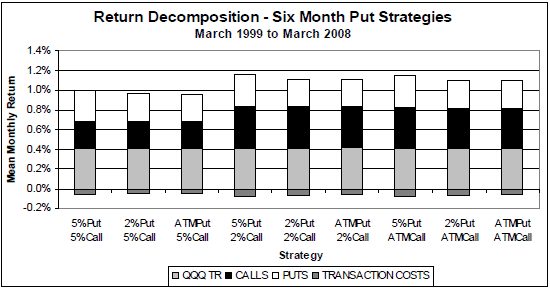Does a long options collar effectively hedge a broad equity exchange-traded fund (ETF), protecting against the downside while capturing a reasonable upside? In their April 2008 paper entitled “Collaring the Cube: Protection Options for a QQQ ETF Portfolio”, Edward Szado and Hossein Kazemi examine the risk-return characteristics of a passive (mechanical, no market timing) long collar strategy on the Powershares QQQ trust ETF (QQQQ), including transaction costs. A collar consists of a put option position to protect an underlying long equity position, combined with covered call options on the same underlying to fund the puts (thereby limiting upside potential). The authors consider 27 different collar combinations by varying moneyness of the puts and calls (5% out-of-the-money, 2% out-of-the-money and at-the-money) and the initial time to maturity of the puts (one, three and six months). Initial time to maturity for calls is always one month. Using daily closing prices for QQQQ and the selected put and call options over the period March 1999 to March 2008 (108 months), they conclude that:
- Over the entire sample period, the QQQQ collar returns are generally closer to normal than the QQQQ returns.
- While the underlying QQQQ generates an annualized return of -1.7%, the annualized returns of the 27 collar strategies range from a low of -1.8% to a high of +12.9% for the collar composed of 5% out-of-the-money, 6-month puts and 2% out-of-the-money calls.
- Drastic reduction in volatility (annualized standard deviation of returns) is the most striking characteristic of the collars, with volatilities ranging from 4.0% 12.8%, compared to 29.9% for QQQQ.
- The minimum monthly return of the collar strategies ranges from -9.2% to -2.2% (versus -25.5% for QQQQ). Maximum drawdown for the collar strategies ranges from -45.4% to -8.1% (versus -80.4% for the QQQQ).
- While no single collar combination outperforms all others on all measures, the collars using 6-month puts outperform those using 1-month and 3-month puts on most measures.
The following chart, taken from the paper, summarizes the contributions to mean monthly collar strategy returns over the entire sample period from:
- The underlying long QQQQ position;
- The long put position initially six months from maturity;
- The short call position initially one month from maturity; and,
- Transaction costs.
Initial moneyness combinations cover 5% out-of-the-money, 2% out-of-the-money and at-the-money (ATM) for both the puts and calls. On average over the sample period, both the put protection and the short call position make substantial return contributions. The positive returns of the short call position suggest that the collar strategies typically outperform simple protective puts.
During the March 1999 through March 2003 subperiod, the put position dominates mean returns (and the collar outperforms the underlying). During the April 2003 through March 2008 subperiod, the underlying QQQQ position dominates mean returns (and the underlying outperforms the collar). Variation of collar combination with general market trend (such as QQQQ above or below a long-term moving average) may enhance collar performance.

In summary, a long options collar on a broad ETF generally outperforms the ETF over the past decade, and a return decomposition indicates that it also outperforms the ETF with protective puts.